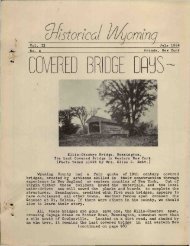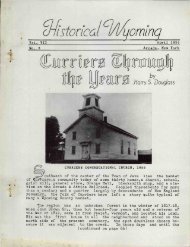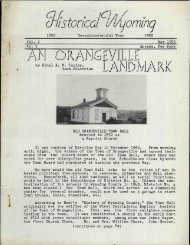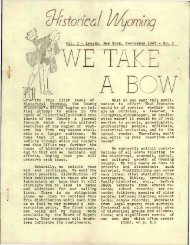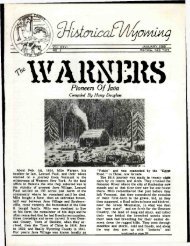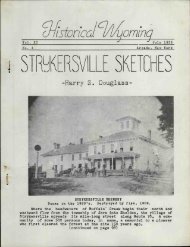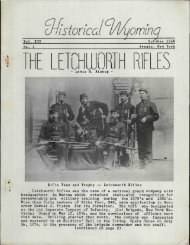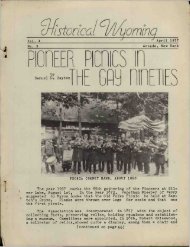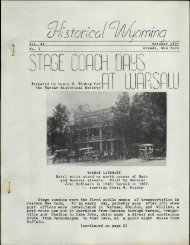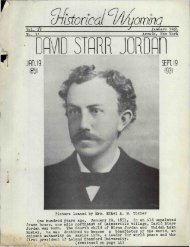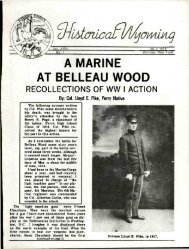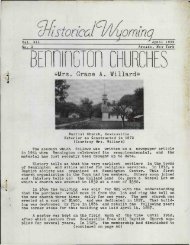By C. Kihm Richardson Walking from Strykersville ... - Fulton History
By C. Kihm Richardson Walking from Strykersville ... - Fulton History
By C. Kihm Richardson Walking from Strykersville ... - Fulton History
You also want an ePaper? Increase the reach of your titles
YUMPU automatically turns print PDFs into web optimized ePapers that Google loves.
APRIL 1978<br />
Thoughts on Pioneer Living (continued)<br />
usually wore a bell so they could be found. To<br />
churn the butter, the cream was put into a large<br />
bottle or jug and shaken, until they had butter.<br />
Neighbors who owned cows would put their milk<br />
together to make cheese. It was pressed into a<br />
four quart or peck measure according to size,<br />
and for a press it was placed under a log.<br />
"It was often a long time before a barn was<br />
built, and some men would get up nights and chase<br />
their cows around so they would not freeze."<br />
SPINNING AND WEAVING<br />
"Nearly all cabins raised a small patch of flax.<br />
The women spun and wove it into cloth for clothes<br />
and general use. Sheep were soon bought, and then<br />
woolen clothes were also made, but wolves were so<br />
numerous that at first it was difficult to keep<br />
sheep.<br />
"Women spun tow (flax), wove it and then made<br />
into bags, for which they received twenty-five<br />
cents each. They also braided whip-lashes; David<br />
Vaughn bought a horse for sixty dollars and paid<br />
it all by selling whip-lashes.<br />
"Deer hides were made into braided lashes of<br />
six or seven strands each. A settler's daughter<br />
braided and sold enough whip-lashes to buy a silk<br />
dress.<br />
"A Mrs. Weaver made a coat for a neighbor, receiving<br />
one dollar for it. She bought a bushel of<br />
wheat with it; her husband cleared off enough land<br />
to sow the whole of it that year.<br />
"The washboards of early years were simply<br />
pieces of boards. With a paddle, called a "battle,"<br />
they pressed out the dirt.<br />
' 'The time of day was told by cutting notches on<br />
the door sill if it was on the south side of the house.<br />
This would answer well when the sun shone so they<br />
could keep track of the shadow."<br />
RECREATION - SOCIAL LIFE<br />
We must not think of the pioneers as being discouraged;<br />
they were doubtless as happy as we are<br />
today. Their social life combined healthy exercise<br />
with fun; log-rollings, husking bees, spelling<br />
schools, barn or house raisings, besides evening<br />
visits. We are told that after log rolling, when<br />
supper was over they would sing hymns and songs<br />
and sit and visit. Their nearest neighbor might be<br />
three or four miles distant; they had no conveyance<br />
but an ox team and sled; no roads but blazed<br />
trees, yet they would go for the evening. Oftimes<br />
there was little to offer a guest, but they did not<br />
worry; they had as good as their neighbors, sometimes<br />
only potatoes and salt.<br />
Mrs. Chapman Brooks often told of the first<br />
time she was invited out to tea; it was at Samuel<br />
Persons' who then lived where Dr. Bixby's house<br />
now stands. The Persons family were considered<br />
well-to-do and had the best things of any around.<br />
PAGE 95<br />
wmmmm .nj*<br />
Miss Kathy Rice of Perry working at old loom<br />
in Wyoming County Pioneer House in Pike.<br />
Thelma Robinson of Castile copking up a stew for<br />
Fair visitors in the Wyoming County Pioneer<br />
House.<br />
They had wooden plates and wooden forks and<br />
some pewter dishes. For supper, there were<br />
johnnycakes, sage tea and fried pork. The pork<br />
was fried, cut in small pieces and put on the<br />
pewter platters in the center of the table. There<br />
was no butter. Each would reach over, take a<br />
small piece of pork as a relish for the johnnycake.<br />
A lump of (maple?) sugar was suspended by a<br />
string and hung over the table. Each in turn would<br />
take a bite as it swung to and fro.<br />
Cowcabbage, called poor-man's cabbage, was<br />
cooked and eaten. Sometimes they had little else.<br />
The first hen on record here (Rushford) was<br />
brought by a woman on the Centerville Road.<br />
Someone had given her the hen and fifteen eggs.<br />
She set the hen and raised the first chickens in<br />
Rushford.<br />
RELATIONS WITH INDIANS<br />
The Indians of the Holland Purchase that<br />
came into contact with the settlers, were usually<br />
amicable. Under the terms of the Pickering Treaty,<br />
the Indians agreed to move into the various reservations<br />
in New York State, but could move <strong>from</strong><br />
(continued on page 96)



